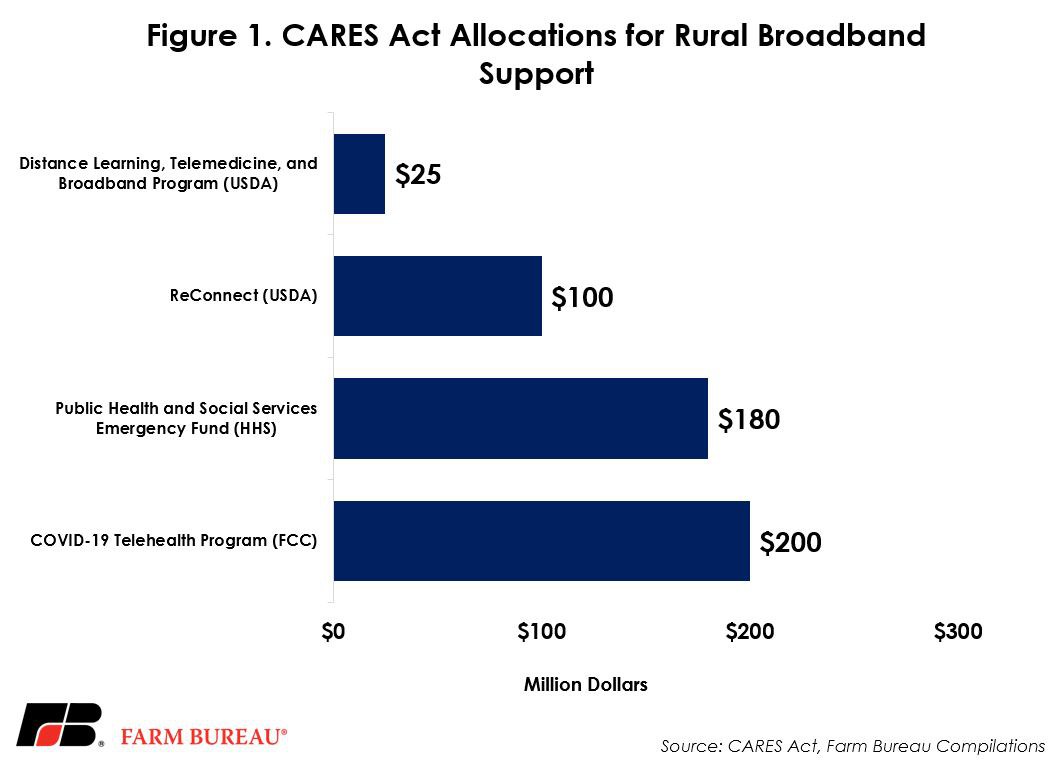Keeping Rural Communities Connected while Socially Distanced
TOPICS
Rural BroadbandMegan Nelson
Economic Analyst

photo credit: Getty
Megan Nelson
Economic Analyst
Like all families, farm families have many worries about the COVID-19 health crisis, and the lack of broadband access adds another obstacle. Never has the need for broadband deployment funding been more obvious. School districts around the country are opening virtually and health care services are operating via telehealth platforms, yet more than 19 million rural Americans do not have high-speed internet access.
This Market Intel highlights the congressional and executive actions related to rural broadband expansion during the COVID-19 emergency. For more information on the telemedicine needs of rural Americans, see “Rural Americans’ Health Depends on Broadband Access.”
Coronavirus Aid, Relief, and Economic Security Act
Signed into law March 27, the Coronavirus Aid, Relief, and Economic Security (CARES) Act allocates more than $500 million to help rural communities connect to broadband internet.
The CARES Act included $100 million for USDA’s Rural Utility Service’s Reconnect Pilot Program, which provides grants for the construction, improvement, or acquisition of facilities and equipment needed to provide broadband service in eligible rural areas. The CARES Act also increases RUS’ Distance Learning, Telemedicine, and Broadband Program funding by $25 million, allowing the agency to provide additional grants to support rural communities’ access to telecommunications-enabled information, audio and video equipment.
To support the growing need for telehealth services due to the COVID-19 emergency, the CARES Act also provided the Federal Communications Commission with $200 million for its COVID-19 Telehealth Program. The program supports eligible health care providers responding to COVID-19 by providing telecommunications services, information services and the devices necessary to enable telehealth services.
Additionally, the measure set aside $180 million from the $127 billion increase in funding for the Department of Health and Human Services’ Public Health and Social Services Emergency Fund to expand services and capacity for rural hospitals, including telehealth.

Health and Economic Recovery Omnibus Emergency Solutions Act
On May 15, the House passed the Health and Economic Recovery Omnibus Emergency Solutions (HEROES) Act, which would provide $8.8 billion for the creation of the Emergency Broadband Connectivity Fund within the FCC to be used through Sept. 30, 2021. The fund would focus primarily on subsidizing broadband connectivity for schools, libraries and low-income households, providing an internet bill discount of up to $50. The HEROES Act also includes a $5-billion increase to the FCC’s E-Rate program for schools and libraries to purchase Wi-Fi hotspots, modems, routers and other connection-related devices for students who do not have broadband access.
Additionally, the HEROES Act provides $2 billion to the Universal Service Fund’s Healthcare Connect Fund Program for eligible health care providers for telecommunications and broadband services necessary to improve the quality of health care available to patients in rural communities.
The House legislation also includes prescriptive funding for the Broadband DATA Act, providing $24 million to improve the accuracy of broadband coverage and better direct federal funds for broadband build-out.
Health, Economic Assistance, Liability Protection and Schools Act
The Senate announced the details of their Health, Economic Assistance, Liability Protection and Schools (HEALS) Act on July 27. The HEALS Act does not propose any specific allocations for broadband build-out, however, it does provide $1 billion for the Secure and Trusted Communications Networks Reimbursement Program. The program provides small, rural telecommunications providers funds to offset the cost of removing prohibited equipment that poses national security risks to their networks and replacing it with more secure technology. The FCC initiative took shape after two companies – Huawei and ZTE – were designated as threats to the communications supply chain.
Also included in the Senate legislation is $78.1 billion for the Public Health and Social Services Emergency Fund, which can be used for telehealth access, among other initiatives.
Executive Order on Improving Rural Health and Telehealth Access
On August 3, President Donald Trump signed the Executive Order on Improving Rural Health and Telehealth Access. The order outlines the administration’s directives to expand telehealth services during the COVID-19 emergency and after. Focusing on rural accessibility, the administration’s order is centered on infrastructure build-out to enable wider telehealth measures and investigating needed regulatory reform to fast-track these services.
Summary
The COVID-19 emergency persists throughout the nation, alongside the growing digital divide. Rural residents and the health care providers and schools that serve them are more reliant than ever on telehealth and distance learning infrastructure, which are only as effective as the broadband connecting them.
The CARES Act allocated more than $500 million for rural broadband programs and negotiations are underway for the next stimulus package. Rural communities are hopeful the next bill will include additional funding to reduce the digital divide.
Trending Topics
VIEW ALL